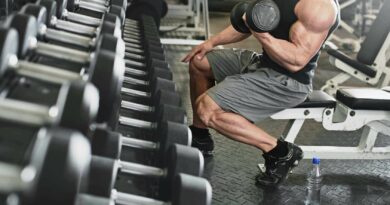How do Muscles Grow: The Science Behind it
Muscle growth, or hypertrophy, is a complex process that involves a combination of factors, including exercise, nutrition, genetics, and hormones. While many people believe that simply lifting weights or doing other resistance exercises will lead to muscle growth, the reality is much more nuanced. In this article, we will explore the science behind muscle growth and how you can optimize your workouts and nutrition to promote muscle hypertrophy.
Muscle fibers
To understand muscle growth, it’s important to first understand muscle fibers. There are two main types of muscle fibers: slow-twitch (Type I) and fast-twitch (Type II). Slow-twitch fibers are used for endurance activities, such as distance running, while fast-twitch fibers are used for explosive movements, such as sprinting or weightlifting.
When you exercise, you recruit muscle fibers to perform the movement, the type of exercise and the intensity of the exercise will determine which muscle fibers are recruited. For example, endurance exercise primarily recruits slow-twitch fibers, while resistance exercise recruits both slow-twitch and fast-twitch fibers.
Muscle damage and repair
When you perform resistance exercise, you create micro-tears in your muscle fibers. This may sound counterintuitive, but it’s actually a necessary part of the muscle growth process. When these micro-tears occur, your body responds by initiating a repair process that leads to muscle growth.
During the repair process, satellite cells, which are located on the surface of muscle fibers, are activated. These satellite cells fuse with the damaged muscle fibers, which leads to an increase in muscle protein synthesis. Muscle protein synthesis is the process by which your body builds new muscle tissue.
Nutrition
Proper nutrition is essential for muscle growth. Your body needs a sufficient amount of protein to support muscle protein synthesis. Aim for a protein intake of at least 1 gram per pound of body weight per day. In addition to protein, your body also needs carbohydrates and healthy fats for energy and overall health.
Timing is also important when it comes to nutrition and muscle growth. To optimize muscle protein synthesis, aim to consume a protein-rich meal within 30 minutes to an hour after your workout. This will help provide your body with the nutrients it needs to repair and build muscle tissue.
Hormones
Hormones also play a role in muscle growth. Testosterone, in particular, is an important hormone for muscle hypertrophy. Testosterone helps to increase muscle protein synthesis, which leads to muscle growth. Resistance exercise can help to increase testosterone levels, but it’s important to note that testosterone levels can vary based on age, sex, and other factors.
Other hormones, such as growth hormone and insulin-like growth factor 1 (IGF-1), also play a role in muscle growth. These hormones help to stimulate muscle protein synthesis and can be increased through proper exercise and nutrition.
Training variables
When it comes to training variables, there are several factors that can impact muscle growth. Understanding these variables and how to manipulate them can help you design an effective training program for maximizing hypertrophy.
Exercise type
Resistance exercise is the most effective type of exercise for muscle growth. Within resistance training, there are two main categories: compound exercises and isolation exercises. Compound exercises, such as squats and deadlifts, are particularly effective for hypertrophy as they recruit multiple muscle groups. Isolation exercises, on the other hand, target a specific muscle group and may be used to supplement a compound exercise or to target a muscle group that is lagging behind in development.
Exercise intensity
Intensity refers to the amount of weight lifted during an exercise. Higher intensity exercises have been shown to lead to greater muscle growth. This is because high-intensity exercises create a greater stimulus for muscle growth by causing micro-tears in the muscle fibers. This damage triggers the body’s repair and rebuilding processes, leading to hypertrophy. However, it’s important to note that high-intensity exercises also place greater stress on the body, so it’s important to progress gradually and use proper form to avoid injury.
Exercise Volume
Volume refers to the total amount of work performed during an exercise. It can be increased by adding more sets, reps, or weight. Generally, higher volume exercises have been shown to lead to greater muscle growth. This is because increased volume creates more stress on the muscle fibers, leading to more damage and thus more hypertrophy. However, as with intensity, it’s important to progress gradually and use proper form to avoid injury.
Exercise Frequency
Frequency refers to how often you perform a particular exercise or workout. While there is no one-size-fits-all approach to frequency, it’s generally recommended to train each muscle group at least twice per week to maximize hypertrophy. This allows for adequate recovery time between workouts while still providing enough stimulus for muscle growth.
Exercise Selection
Exercise selection refers to the specific exercises you choose to include in your workout program. To maximize hypertrophy, it’s important to choose exercises that target the muscle groups you want to develop. This means selecting exercises that challenge the muscle fibers through a full range of motion and provide adequate resistance.
Rest Periods
Rest periods refer to the amount of time you take between sets or exercises. Generally, shorter rest periods have been shown to lead to greater muscle growth as they create more metabolic stress on the muscle fibers. However, it’s important to balance shorter rest periods with adequate recovery time to avoid overtraining.
Overall, by understanding these training variables and how to manipulate them, you can design an effective workout program that maximizes hypertrophy and helps you reach your muscle-building goals. It’s important to remember to progress gradually and use proper form to avoid injury, and to prioritize rest and recovery to support muscle growth.
References:
- Schoenfeld, B. J. (2010). The mechanisms of muscle hypertrophy and their application to resistance training. The Journal of Strength & Conditioning Research, 24(10), 2857-2872.
- Hawley, J. A., & Burke, L. M. (2011). Peak performance: training and nutritional strategies for sport. Allen & Unwin.
- Phillips, S. M., & Van Loon, L. J. (2011). Dietary protein for athletes: from requirements to optimum adaptation. Journal of sports sciences, 29 (sup1), S29-S38.
- West, D. W., & Phillips, S. M. (2010). Anabolic processes in human skeletal muscle: restoring the identities of growth hormone and testosterone. Physiological reviews, 90(2), 449-482.
- Kraemer, W. J., & Ratamess, N. A. (2005). Hormonal responses and adaptations to resistance exercise and training. Sports Medicine, 35(4), 339-361.
- American College of Sports Medicine. (2009). American College of Sports Medicine position stand. Progression models in resistance training for healthy adults. Medicine and Science in Sports and Exercise, 41(3), 687-708.



Itís nearly impossible to find educated people for this subject, but you sound like you know what youíre talking about! Thanks
Good post. I learn something totally new and challenging on websites I stumbleupon every day. Its always exciting to read articles from other writers and practice a little something from other sites.